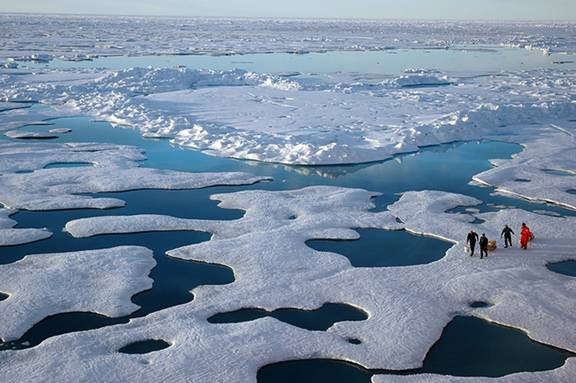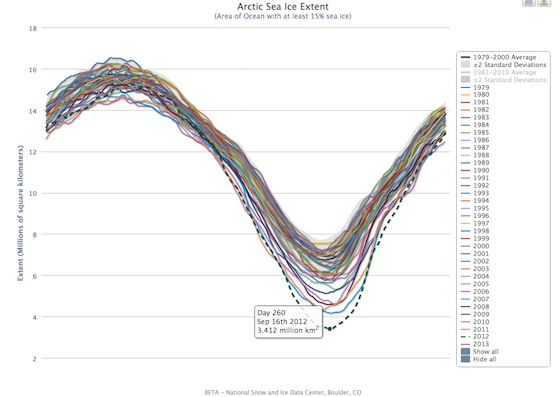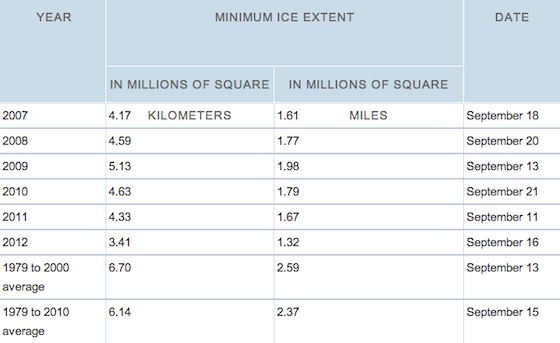Arctic Will Be Almost-Completely Ice-Free By 2020
By Countercurrents.org
13 April 2013
Countercurrents.org

The Arctic is melting much faster than most studies previously predicted. As early as 2020 and not later than 2050 it will be almost completely ice-free, according to a new study by the US National Oceanic Atmospheric Administration. [1]
"It's pretty scary how rapidly all this Arctic change is happening," said James Overland, lead author of the new study, and a research oceanographer with the NOAA. "The Arctic is a real indicator of global change here, that's why we wrote the paper," he told The Verge.
Specifically, Overland explained that the loss of the majority of Arctic sea ice during future summer melt seasons will have three major impacts: it will open the door for drilling and shipping in the region, it will ruin the habitats for polar bears and marine mammals, and eventually, it could cause more extreme weather events for us who live down in the more southern latitudes. "It's hard right now to say that 'this particular snowstorm two years ago was caused by what was going on in the Arctic,' or that the path of Hurricane Sandy was caused by Arctic changes, but there are indications we will see more extreme weather as the Arctic warms up."

Graph of sea ice loss maximum and minimum from 1979 through 2013, from the National Snow and Ice Data Center
It's important to point out that the Arctic is likely to still always be covered by a little bit of ice, according to Overland and his colleague's projections, and other future models of Earth's temperature.
"Ten to fifteen percent will still be there during the winter," said Overland. Every year, large areas — hundreds of thousands of square miles across — of Arctic sea ice melt during the summer and refreeze each winter, part of a naturally occurring seasonal process.
But the amount of sea ice lost in the summer has been exacerbated in recent years by global warming, which Overland and others have linked to a rise in human produced GHG emissions. Last year saw a record amount of sea ice melt, according to NOAA. And overall, the trend is going way down. "We've already lost three fourths of the sea ice volume since the 1980s," Overland said.

Chart of Arctic sea ice minimum and maximum from 1979 to 2012, from the National Snow and Ice Data Center
Previous studies have projected that the Arctic could see its first ice-free summer sometime between 2015 and 2100. The new meta-study (a study of 36 previous computer models used by the UN and others to predict Arctic climate change) published this week in the journal Geophysical Research Letters, indicates that the answer is likely right in-between those extremes.
The study attempted to narrow the discrepancy between previous ones by looking at more recently observed data. "Eighty percent of the [previous] models are too slow to start with, and probably more than that." Overland told
Another report added [1]:
Nearly ice-free summers in the Arctic , the two scientists say, will be before 2050 and possibly within the next decade or two.
James Overland of NOAA's Pacific Marine Environmental Laboratory and Muyin Wang of the NOAA Joint Institute for the Study of Atmosphere and Ocean at the University of Washington, looked at three methods of predicting when the Arctic will be nearly ice free in the summer.
Rapid Arctic sea ice loss leads to shifts in ecosystems and economic access, and potentially impacts weather throughout the northern hemisphere, said Overland. "Increased physical understanding of rapid Arctic climate shifts and improved models are needed that give a more detailed picture and timing of what to expect so we can better prepare and adapt to such changes. Early loss of Arctic sea ice gives immediacy to the issue of climate change."
"There is no one perfect way to predict summer sea ice loss in the Arctic ," said Wang. "So we looked at three approaches that result in widely different dates, but all three suggest nearly sea ice-free summers in the Arctic before the middle of this century."
Overland and Wang emphasized that the term "nearly" ice free is important as some sea ice is expected to remain north of the Canadian Archipelago and Greenland .
The "trendsetters" approach uses observed sea ice trends. These data show that the total amount of sea ice decreased rapidly over the previous decade. Using those trends, this approach extrapolates to a nearly sea ice-free Arctic by 2020.
The "stochasters" approach is based on assuming future multiple, but random in time, large sea ice loss events such as those that occurred in 2007 and 2012. This method estimates it would take several more events to reach a nearly sea ice-free state in the summer.
Using the likelihood of such events, this approach suggests a nearly sea ice-free Arctic by about 2030 but with large uncertainty in timing.
The "modelers" approach is based on using the large collection of global climate model results to predict atmosphere, ocean, land, and sea ice conditions over time. These models show the earliest possible loss of sea ice to be around 2040 as GHG concentrations increase and the Arctic warms. But the median timing of sea ice loss in these models is closer to 2060. There are several reasons to consider that this median timing of sea ice loss in these models may be too slow.
"Some people may interpret this to mean that models are not useful. Quite the opposite," said Overland . "Models are based on chemical and physical climate processes and we need better models for the Arctic as the importance of that region continues to grow."
Taken together, the range among the multiple approaches still suggests that it is very likely that the timing for future sea ice loss will be within the first half of the 21st century, with a possibility of major loss within a decade or two.
Source:
[1] The Verge, Carl Franzen, Apr. 12, 2013 , “Arctic will be basically ice-free by summer 2050, NOAA study says”,
http://www.theverge.com/2013/4/12/4217786/arctic-ice-free-summer-2050-noaa-study
[2] Story Source:
The story is reprinted from materials provided by NOAA.
Journal Reference:
James E. Overland, Muyin Wang. When will the summer arctic be nearly sea ice free? Geophysical Research Letters, 2013; DOI: 10.1002/grl.50316
Source:
National Oceanic and Atmospheric Administration (2013, April 12). Arctic nearly free of summer sea ice during first half of 21st century, experts predict. ScienceDaily. Retrieved April 13, 2013 , from
http://www.sciencedaily.com /releases/2013/04/130412142848.htm?utm_source=
feedburner&utm_medium=feed&utm_campaign=Feed%3A+sciencedaily+%28ScienceDaily%3
A+Latest+Science+News%29
Comments are moderated


